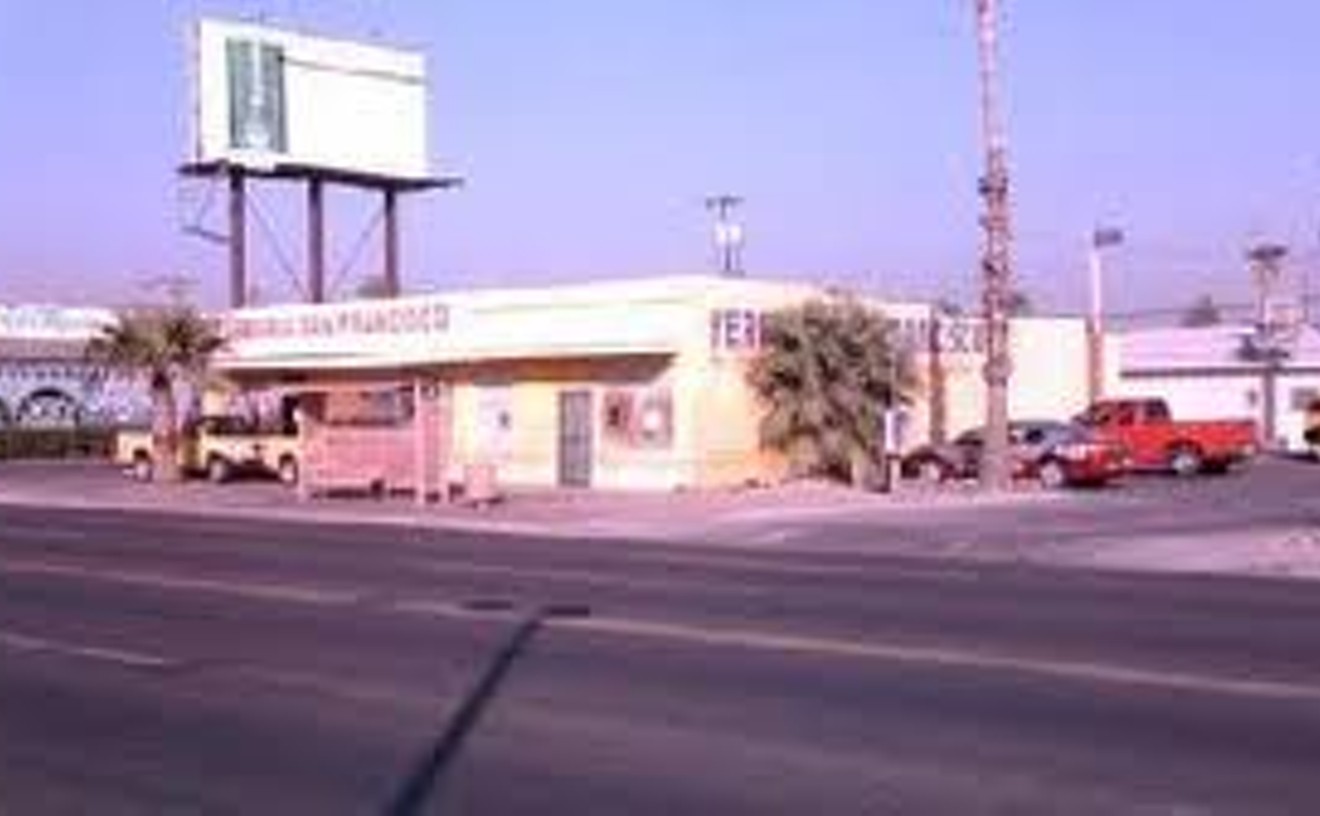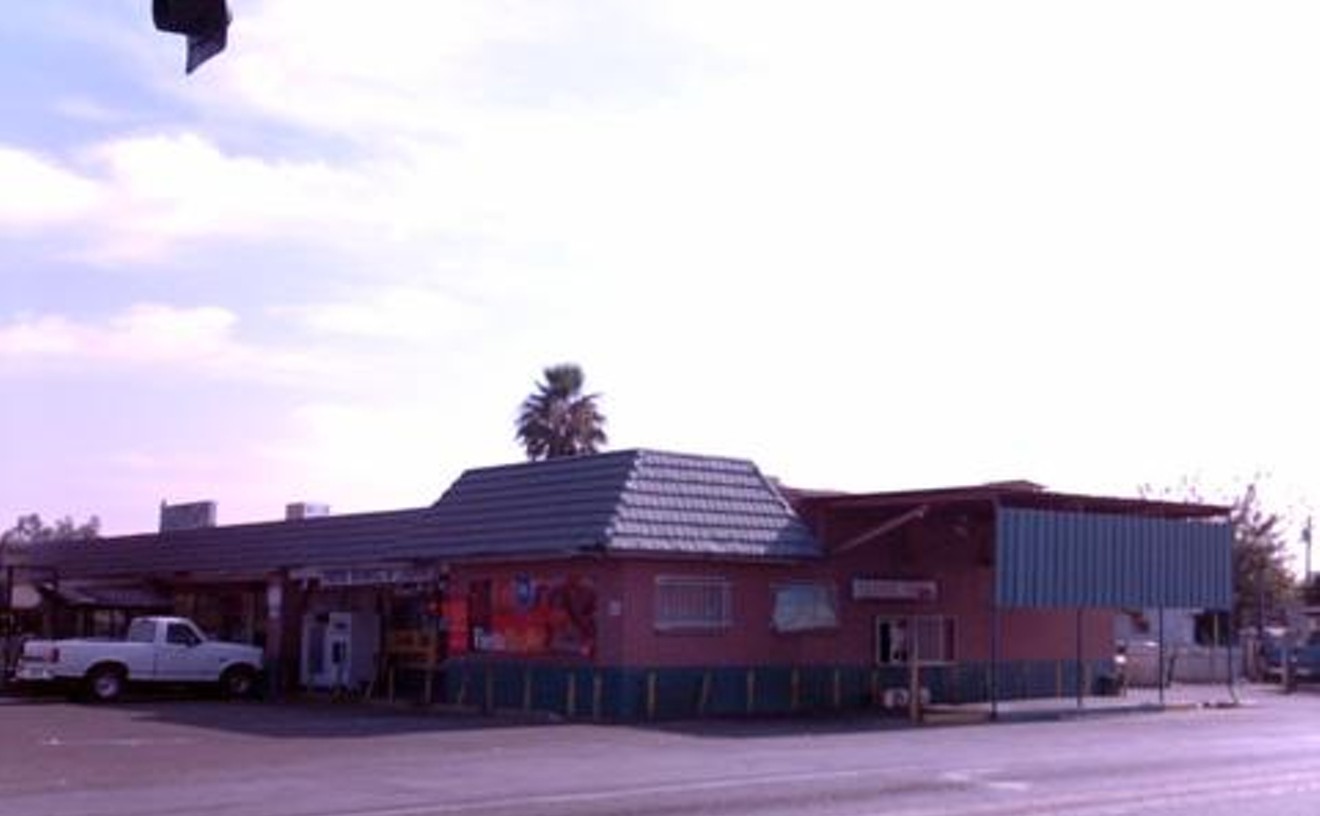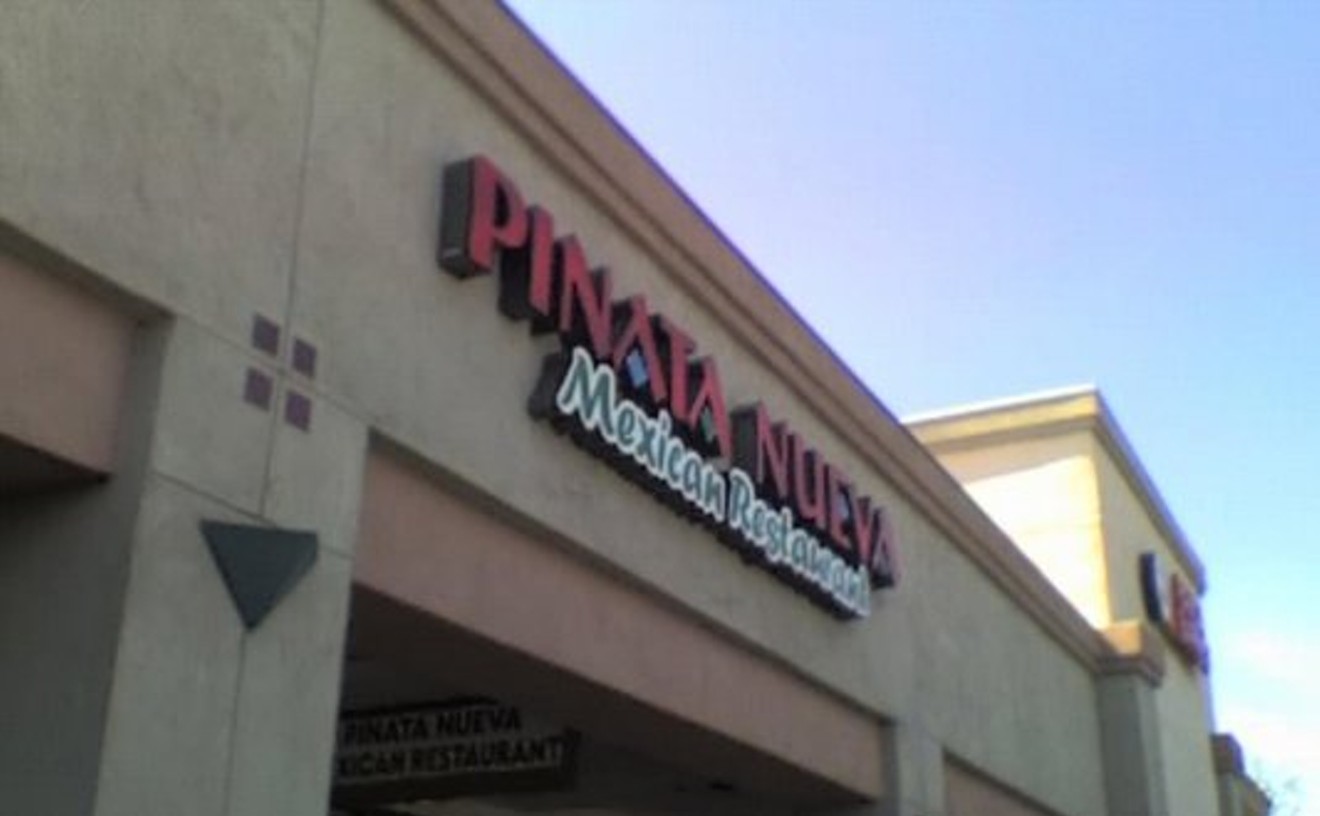BEST PLACE TO FIND A STATUE OF SANTISIMA MUERTE
Yerbería San Francisco

Ever see those statues of what appear to be the Grim Reaper in drag at the swap meet? That, mis amigos, is La Santisima Muerte -- Most Holy Death. She's the subject of a fast-growing cult in Mexico that considers her a powerful saint, though the Catholic Church has banned her from its approved saints list (which now excludes the saint of surfer dudes everywhere, Saint Christopher). Actually, cultural experts consider La Santisima Muerte the Catholic folk disguise for Mictlancihuatl, the ancient Aztec death goddess and co-regent of the dark underworld. Mictlancihuatl happens to be the sister of the Aztec goddess Tonantzin, whose Catholic incarnation is the Virgin of Guadalupe. You could say Santisima Muerte is the dark flip side of Guadalupe, a sort of Virgin Mary represented as a skeleton. And though she's extremely popular with the less savory elements of society, she's acquiring street cred among respectable folks who invoke her powers for love spells. Yerbería San Francisco has a Santisima Muerte selection to die for, so to speak. From small statuettes to three-foot-high sculptures, this is a must stop if you're looking for love in all the right places but it's just not happening, or you've got a wandering boo who's making you boo-hoo.
- 2718 W. Van Buren St., Phoenix, 85009 Map
- 602-233-2163
- yerberiasanfrancisco.lbu.com
BEST PLACE TO FIND A STATUE OF JESUS MALVERDE
Yerbería Fuente de Salud
We first stumbled upon the mysterious Jesus Malverde years ago during a trip through Magdalena, Sonora. We couldn't figure out the story behind the statues and busts of a dashing Errol Flynn look-alike that we just had to buy at a large religious store there, and the counter girl waiting on us wasn't very forthcoming about his history or the reason his prayer card depicted him with a noose around his neck. Later, we discovered the Holy Swashbuckler was none other than Jesus Malverde, El Bandido Generoso, who stole from the rich and gave to the poor. He's a not-so-underground folk saint particularly popular in Sinaloa, whence he allegedly came, and was summarily dispatched by hanging (there are several different versions of how he died) in the 1920s. Whether Malverde ever actually existed is really unimportant to his huge, adoring fan base, which conspicuously includes narcotraficantes, a.k.a. international drug smugglers. Since discovering his true identity, we've been voraciously collecting Jesus Malverde effigies in all their glory. Yerbería Fuente de Salud carries a number of Malverde busts, but we truly cherish our new addition to the collection: a leather-backed, embroidered necklace with Malverde's face on it that we got there recently for a mere $4.95.
- 3015 E. Thomas Road, Ste., Phoenix, 85018 Map
- 602-956-6263
BEST MEXICAN BOTANICA
Yerbería La Esperanza

For some reason, here in Phoenix, botanicas are uniformly called yerberías. But a rosa by any other name is still a rosa, and, whatever you want to call them, they're one and the same: specialty stores that sell a bewildering variety of medicinal herbs and religious supplies used for both natural remedies and curanderismo, a lively blend of folk cures, white magic and pidgin Catholicism. Spiritualism, occultism, medieval Spanish Catholic traditions and folk healing all meet and greet one another in your typical yerbería, a convenient stop where you can buy herbs and tree bark to lower your blood pressure, buy a Buddha for good luck, snag a Virgin of Guadalupe for your home altar, or acquire candles and powders to cast a spell. And at Yerbería La Esperanza, we always find crucifixes, good-luck amulets, statues of saints that we know for a fact are used in Afro-Cuban santería practices (which are becoming very mainstream in Mexico), and an entire wall of neatly packaged natural remedies that can also double as offerings in a number of rituals. This shopping spot even has several very cool statues of San Simon of Guatemala, another one of those folk deities deemed naughty by the Catholic Church, but who still has a devoted following throughout Latin America.
- 3037 W. Van Buren St., Phoenix, 85009 Map
- 602-272-8112
BEST PLACE TO FEEL LIKE YOU'RE IN A MERCADO IN MEXICO
Dos Hermanos Centro Comercial
Just like in Mexico, this large indoor mercado, lined with small, individual businesses, is a one-stop-shopping destination that houses just about everything you could possibly want or need to make your life complete. Visit Friendly Records for Mexican music CDs in every genre, or bargain for over-the-top laminated and ormolu-encrusted 19th-century French repro furniture -- the apex of Mexican middle-class fashion -- at Let's Make a Deal Furniture. And while you're at it, arrange your next blowout, be it birthday, wedding reception or quinceañera, at the Salon de Fiestas, a part of Dos Hermanos Centro Comercial. Joyería Diaz is ablaze with gold jewelry, and there are several shops, including Novias Gladys, that specialize in wedding paraphernalia like silk flower bouquets, tuxedos and formal wedding attire -- and, for après fiesta, soccer equipment. If you're feeling particularly mainstream holy, cruise by Librería Dios de Amor, a Spanish-language Christian music store, or check out Yerbería Guadalupana, a traditional botanica chock-full of naturopathic remedies, herbs and potions that can also be used for arcane religious rites designed to bring back the wayward groom or beau. And to elevate your plunging blood sugar level after the glucose-depleting intensity of all this shopping, stop by the Mexican candy stand on your way out.
BEST PLACE TO GET HOT WHEEL RIMS AND SEE ART AT THE SAME TIME
4U Used Cars and Tires

We hung the fastest U-turn we could when we spotted the artfully arranged chrome wheel rims standing guard at the entrance to 4U Used Cars and Tires on Van Buren Street. Even though we're usually not into this sort of thing, and admittedly know next to nothing about wheel rims (or cars, for that matter), we were inexplicably seduced by the eye-blasting gleam of 4U's chrome lowrider rims, fashioned into a seamless wall of sparkling pattern; by the come-hither look of the rims' sexy cross-and-radial-spoke patterns; and by the silvery sophistication of the elegant spinners on display. Omigod, the spinners! Ever since we saw 4U's sculptural shrine to car culture, we've been considering putting them on our 1992 Volvo sedan. Seriously.
- 2117 W. Van Buren St., Phoenix, 85031 Map
- 602-271-4557
BEST PIÑATA STORE
La Piñata Nueva

They don't sell anything else but piñatas at La Piñata Nueva. A hundred or so tissue-paper creations of all shapes and sizes hang from the ceiling of the warehouse at 27th Avenue and Thomas Road: Traditional Mexican star-shaped piñatas share space with Scooby-Doos, Winnie the Poohs, Spidermen, and Shreks. The piñatas are made here, on site, by women who watch telenovelas as they layer sheets of colored crepe paper over cardboard forms. The folks at La Piñata Nueva can make a custom piñata to almost any size and shape you want; just bring them a picture of what you're after, and they'll craft it for you. They also sell bags of candy and trinkets to put into the piñatas, and crepe-paper-covered sticks for busting them open. The prices are reasonable -- a four-foot-tall Dora the Explorer piñata, for example, runs only $20. ¡Andale!
- 2740 W. Thomas Rd., Phoenix, 85031 Map
- 602-455-9256
BEST PLACE TO FIND A QUINCEAÑERA DRESS
Joyful Events (a.k.a. Wedding Depot)
After we found out about the Latin American tradition of the quinceañera, we really began to feel sorry for Hispanic relatives everywhere. Blame it on the 16th-century Spaniards, or maybe it was those pesky Aztecs, but whoever thought up the idea of marking a 15-year-old girl's passage into womanhood and society with a huge, expensive blowout must have owned all the concessions that catered to this elegant tradition's many requirements. Basically a cross between a debutante's coming-out ball and a Sweet 16 party, the quinceañera celebration, which usually consists of a special Mass, reception and dance, can be likened to an ersatz wedding minus a real groom. The quinceañera herself wears a ball gown with billowy bouffant petticoats and a tiara, and carries a rhinestone-encrusted scepter; she's surrounded by an equally decked-out honor court of damas and chambelanes (up to 14 of each). If the quinceañera's dad is lucky, the whole shebang is underwritten by the kind monetary donations of extended family, godparents and friends. Where to find that perfect ball gown with the billowy bouffant petticoats? Try Joyful Events in Mesa, which carries all the mandatory quinceañera accouterments: the dress, rosary, tiara, scepter, last doll, cake cutter and kneeling pillow (it even carries tux rentals for the male honor court members -- our favorite was a zoot suit, complete with wide-brimmed fedora, two-toned spectator shoes and obligatory long watch chain). The dress choices here seem endless, from your basic fairy princess look to medieval styles that make you resemble a starry-eyed refugee from a Renaissance fair.
BEST MEXICAN FOLK ART STORE IN CYBERSPACE
funkychickeneggranch
When it comes to fabulous Mexican folk art, for sheer variety and eclectic selection, no one can beat funkychickeneggranch. That's the seller's name that native Phoenician Nancy Nenad goes by on eBay, where she maintains a virtual store filled with the sacred, the profane and the downright loony. Go to www.ebay.com and search under sellers for funkychickeneggranch. Co-owner of the now-defunct Saints and Sinners folk art store in Glendale, Nenad prefers today to wheel and deal in cyberspace, which frees her up to sniff around Mexican mercados and artisans' talleres for the finest Mexican folk art to be found. Nenad knows her stuff, since she regularly travels south of the border with her equally adventurous 70-something mamacita, Bets Nenad, who for more than 40 years has been fearlessly scouring tiny Mexican towns for folk art. From funkychickeneggranch, you'll learn about where those retablos, ex-votos, papier-mâché skeletons, sequined saints and Mexican Santería ritual objects come from; their cultural and religious significance; and, often, about the artists who make them, many of whom Nenad knows personally. In fact, Nenad's entertaining auction titles and descriptions alone are worth a trip to her eBay store, like the one for a hot-pants-wearing devil figurine used traditionally for a Mexican Christmas crèche. Nenad swears that "the hot pants look a little like a sagging diaper." Or the "Don't Eat My Rabbit Tin Folk Art Retablo/Ex Voto" from Oaxaca that features a "blob-like image of a saint hovering over the scene" of a father about to consume his kid's rabbit. Muy hilarious!
BEST BRICK-AND-MORTAR MEXICAN FOLK ART STORE
Sueños Latin American Imports

Since the phenomenal rise in popularity of Mexico's DÍas de los Muertos (Day of the Dead to you, gringo) here in the U.S., folk crafts related to this uniquely Mexican celebration of the dearly departed are hot (and sometimes high) ticket items. A shotgun marriage between 16th-century Catholicism's All Souls and All Saints Day in November and ancient pre-Columbian rites honoring the dead, DÍas de los Muertos is celebrated by partying graveside with your ancestors and by creating special offering tables (ofrendas) at home laden with the favorite food, drink and smoking material of the deceased person(s) being commemorated. But where in town can you find those fancifully decorated sugar skulls for adorning your home shrine, now that you've embraced your repressed Mexicanidad? Especially in the middle of April? And, of course, you're gonna need those funky religious candles, holy cards and key chains bearing the likenesses of San MartÍn, San Antonio (patron saint of impossible cases) and Our Lady of Guadalupe as a finishing touch. Try Sueños, a Latin American import store owned by Robert Bitto, who joyfully crams his shop with not only Mexican folk art and crafts, but stuff from Peru, Bolivia and Ecuador -- even Poland, for God's sake -- as well. You'll find an entire wall there devoted to nothing but crosses, enough to keep the vampire population of the entire state of Arizona under control, together with contemporary retablos, nichos, paper flowers, santos, milagros, those fancy clay Posada catrina skeleton sculptures from the town of Capula in Michoacán, hand-blown glassware from Tonala, and talavera from Delores Hidalgo, Guanajuato. This is what we call one-stop religious shopping at its finest.
- 4200 N. 7th Ave., Phoenix, 85013 Map
- 602-265-3486
BEST PLACE TO FIND MEXICAN FOLK ART ONCE A YEAR
Friends of Mexican Art (FOMA) Hacienda Tour and Mercado
Long before the rank-and-file rabble elevated Frida Kahlo and Diego Rivera to Mexican Idol status, Friends of Mexican Art (fondly referred to as FOMA) knew that Mexican fine and folk art were extremely cool. Started here in Phoenix more than 42 years ago (during an era when Day of the Dead most likely referred to your own funeral), FOMA, a nonprofit organization, has dedicated itself to fostering cultural ties with Mexico. For years, the group has raised funds to purchase Mexican art for Arizona art museums, mount Mexican exhibitions, and print art catalogues. FOMA's even underwritten the restoration of important Mexican national patrimony, like historic public murals damaged in Mexico City's 1985 earthquake, and the 18th-century, mural-covered Santuario de Atotonilco in Guanajuato, where Father Hidalgo first announced to the Mexican nation that he was mad as hell and not going to take it from Spain anymore. FOMA's Hacienda Tour con Folk Art Mercado, usually held in February, is its signature fund-raising activity, one that allows patrons to play looky-loo in houses belonging to people like Eddie Basha or Virginia and Jose Cárdenas (he's managing partner of the Lewis and Roca law firm here in town). But the best part of it all is the fabulous folk art mercado organized by longtime FOMA devotee Bets Nenad, who invades Mexican towns throughout the year to rustle up the finest quality crafts Mexico has to offer. It's worth waiting all year long for FOMA's mercado, so if you're a folk art freak, best pencil in this occasion now.





